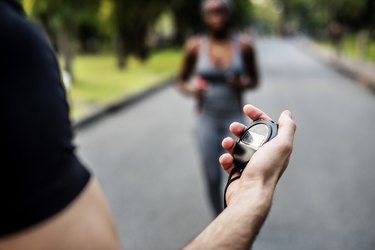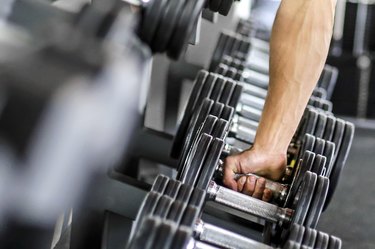
Curious whether you're on track to live a long, healthy life into your golden years? Most health professionals would tell you to hop on a scale because numbers like weight and BMI (body mass index) are often used to predict your chances of developing certain diseases and your life expectancy overall.
The problem? Neither weight nor BMI is truly an accurate or adequate measure of your health.
Video of the Day
Video of the Day
That's because "weight and BMI are not customized to sex or body type, nor do they take into account muscle mass, bone density, overall body composition and cultural differences," says John P. Higgins, MD, a sports cardiologist and professor of cardiovascular medicine at The McGovern Medical School at The University of Texas Health Science Center at Houston (UTHealth).
Take, for example, a bodybuilder with a lot of muscle mass. They may erroneously fall into the overweight or obesity categories for weight or BMI.
Conversely, these metrics don't address the problem of "normal"-weight people with obesity, otherwise known as "skinny fat" (we hate the term, too), who appear thin with average BMIs but have a high percentage of body fat and an increased risk of cardiovascular disease, per a May 2015 study in Cardiovascular Diabetology.
Instead of putting too much weight on weight (pun intended), a growing body of research is finding other measures that may be useful tools for evaluating your health and risk of disease. In fact, these four metrics — walking speed, push-up ability, grip strength, and waist circumference — can reveal more about your state of health than any scale. The best part? You can track them yourself.
Tip
Even though you can calculate these metrics on your own, they're not a substitute for visiting a doctor or getting regular checkups. Better yet, as you gather these measurements at home, share them with your medical provider who can best analyze the numbers for a fuller picture of your health.
1. Your Walking Speed
How fast you stroll is linked to how long you live, according to a June 2019 study in Mayo Clinic Proceedings.
Researchers found that brisk walkers enjoy longer life expectancies than those with a slower stride, regardless of their BMI.
Perhaps this is because walking — as opposed to weight — is a functional measure of several important things: "Walking tests balance, coordination, lower limb and core strength, as well as cardiovascular health," Dr. Higgins says.
Essentially, you need to be in good physical shape to keep up a swift pace.
How to Measure Your Walking Speed:
Walk 1 mile. Then divide the number 60 by how minutes it took you to walk the mile. For example, if you spent 30 minutes strolling (60 divided by 30), your speed would clock in at 2 miles per hour.
Alternatively, time yourself as you walk 6 meters. Divide the number six by how many seconds it took you to complete the 6-meter walk. So, if you walk six meters in three seconds, your pace is 2 meters per second.
Ideally, you should aim for a walking speed that's at least 2.4 miles per hour (that's a 25-minute mile) or 1 meter per second.
2. Your Push-Up Prowess
Because push-ups work your entire body — and require strength and endurance — the number you can complete is another predictor of your overall health status.
"Push-ups are a good measure of both upper-body and core strength, as well as cardiovascular health," Dr. Higgins says. "In short, the more push-ups you can do, the stronger and better cardiovascular system you have."
As a matter of fact, a longitudinal cohort study of 1,100 adult men found that those who could perform more than 40 push-ups had a significantly lower risk of developing heart disease compared with participants who could complete fewer than 10 push-ups, per February 2019 research in JAMA Network Open.
How to Measure Your Push-Ups:
First, work on mastering good form.
- Start in a plank with your hands under your shoulders and your body in a straight line from head to toes.
- Contract your ab muscles so that your hips don't sag and your back doesn't arch.
- Bend your elbows as you lower your chest to the ground, keeping your hips level.
- Your elbows should be about a 45 degree angle away from your body.
- Once you lower as far as you can, push yourself back up to a plank.
Try to perform as many push-ups as possible with perfect technique before tiring. Aim to work your way up to 50 to 100 push-ups per day, Dr. Higgins says.
Ready for a Challenge?
3. Your Grip Strength

Oddly enough, your ability to squeeze a grip meter can forecast whether you'll live to a ripe old age. But why?
Well, grip strength may help to identify muscle — and cardiovascular —weaknesses. That's because how tight you can grip something relates to both your upper-body strength as well as your heart's ability to handle pumping against a higher pressure (because your blood pressure rises with the act of gripping), says Dr. Higgins.
Not convinced? A study of a half million middle-aged people found that weaker grip strength was strongly linked with the occurrence of negative health outcomes, such as lung cancer and heart disease, according to May 2018 research in the BMJ.
What's more, grip strength was an even better predictor of death than blood pressure or overall physical activity.
How to Measure Your Grip Strength:
To calculate grip strength, simply squeeze a handgrip dynamometer at a gym or your doctor's office.
If you don't have access to a grip meter, you can use a bathroom scale, Dr. Higgins says. Simply squeeze the scale with both your hands (thumb on plate and fingers behind scale), record the number, then divide that number of pounds by two. The optimal measurement is about 110 pounds for men and 70 for women.
To improve your grip strength, you need to build muscle. Commit to resistance training two or three times per week.
Dr. Higgins also suggests investing in a pair of handgrip squeezers, such as the Luxon Grip Strengthener ($10.89 for two, Amazon). Do a set of 10 squeezes with each hand twice a day.
4. Your Waist Circumference
A large waist circumference can be a warning sign of future health problems. That's because waist circumference is an indicator of visceral fat, or the hard fat around your organs. In other words, your waist size increases as your internal fat deposits do.
And excessive belly fat is associated with health conditions such as type 2 diabetes, high cholesterol, high triglycerides, high blood pressure and coronary artery disease, according to the Mayo Clinic.
Indeed, a study that looked at data from 650,000 white adults found that a higher waist circumference was connected to a greater incidence of mortality at all levels of BMI, per a March 2014 meta-analysis in Mayo Clinic Proceedings.
How to Measure Waist Circumference:
On your bare stomach, loop a soft tape measure around your waist, just above the upper hip bone. Take the measure while you exhale (but don't suck in your tummy!).
An ideal waist circumference is less than 35 inches for women and less than 40 for men, according to Dr. Higgins.
Keep in mind, though, that there may be ethnic differences when it comes to a healthy waist size. While research is still being done in this area, the International Diabetes Federation defines abdominal obesity for people of South Asian, Chinese and Japanese descent as well as ethnic South and Central Americans as 35.4 inches or greater for men and 31.5 inches or greater for women.
An October 2018 study in BMJ Global Health proposes these cut-offs to be around 37.8 inches for Black women and 35.8 inches for Black men, but more established guidelines need to be set for this population.
Other Health Predictors to Track
When it comes to assessing your heart health, you might also want to keep an eye on your blood pressure and cholesterol levels.
"Blood pressure is a big barometer of cardiovascular health," Dr. Higgins says. "When your blood pressure is chronically high, your cardiovascular system and/or sympathetic nervous system (responsible for your fight-or-flight response) is overstressed."
Whether the root cause of your increased blood pressure relates to something physical, mental, genetic or even lack of sleep, the strain on your body isn't healthy. If your blood pressure is greater than 130/80 on a regular basis, you should see a medical professional, who can help assess your situation and assist you in making healthy lifestyle changes to lower your numbers.
Cholesterol is also a good measure of cardiovascular risk, Dr. Higgins says: "The higher the bad cholesterol (LDL cholesterol), the higher the chance of heart attack and stroke."
While your cholesterol is often strongly tied to genetics, there are still actionable steps you can take to reduce your levels, according to Dr. Higgins, who suggests limiting your saturated fat intake, following a Mediterranean diet with more plant-based foods and exercising regularly to increase your good HDL cholesterol.
- Harvard T.H. Chan School of Public Health: “Ethnic Differences in BMI and Disease Risk.”
- Mayo Clinic Proceedings: “A pooled analysis of waist circumference and mortality in 650,000 adults.”
- Cardiovascular Diabetology. “Normal-weight obesity is associated with increased risk of subclinical atherosclerosis.”
- Mayo Clinic Proceedings: “Comparative Relevance of Physical Fitness and Adiposity on Life Expectancy.”
- JAMA Network Open: “Association Between Push-up Exercise Capacity and Future Cardiovascular Events Among Active Adult Men.”
- Mayo Clinic: “Is it true that waist size can be a predictor of life expectancy?”
- BMJ: “Associations of grip strength with cardiovascular, respiratory, and cancer outcomes and all cause mortality: prospective cohort study of half a million UK Biobank participants.”
- Harvard T.H. Chan School of Public Health: "Abdominal Obesity Measurement Guidelines for Different Ethnic Groups"
- BMJ Global Health: "Do current guidelines for waist circumference apply to black Africans? Prediction of insulin resistance by waist circumference among Africans living in America"